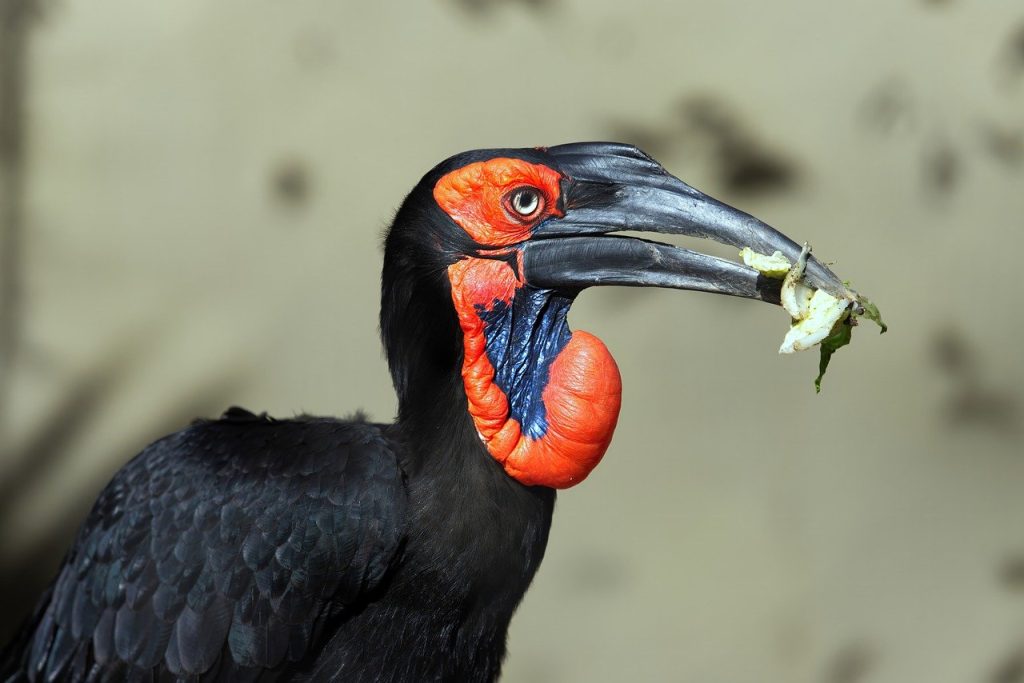
The African savanna supports an abundance of wildlife. Characterized by an extensive cover of grasses and scattered trees, the savanna provides both nesting sites as well as suitable hunting grounds for a diversity of bird species. This element, coupled with its accessibility, makes the savanna biome a haven for African safaris and birding.
Among the birds often encountered in the savannas of Africa are the hornbills, bee-eaters, oxpeckers, and kingfishers. Birders are also likely to see flocks of vultures circling the skies or perched atop a tree, eagerly awaiting their turn at a fresh carcass.
Let’s take a look at some of the common as well as sought-after species to look out for in the African Savannas.
1. Helmeted Guineafowl
An almost comically peculiar gallinaceous bird, the helmeted guineafowl is a fairly common gamebird sighting amid the grasses of the African savanna. Flocks scurry along the game paths, feasting on grass seeds, tubers, flowers, and other plant materials.
They also eat beetles, snails, insect larvae, and ticks, among other invertebrates and even some small vertebrates such as mice, playing a role in the control of pests and diseases. The helmeted guineafowl is an unmistakable species named for its vibrant blue or red—or a combination of blue and red—facial skin. It also sports a peculiar bony casque, and rows of tiny white spots adorn its plumage. Helmeted guineafowl are well-adapted to their terrestrial lifestyle. They can cover over 10 kilometers in a single day and can run swiftly with surprising stability across uneven terrain. Like most landfowl, they are weak fliers but are capable of an explosive, albeit short flight to escape predators or when disturbed, issuing a harsh alarm call.
2. Woodland Kingfisher
The loud, dual-note trilling call of this tree kingfisher can be heard in wooded habitats throughout tropical Africa. Like many other kingfisher species, the woodland kingfisher does not subsist on a piscivorous diet. Instead, it feeds primarily on insects and the occasional lizard, frog, or other small vertebrate.
It is an attractive bird with an electric-blue back, tail, and wing panels, outstanding against a pale grey head and underparts. Its large, bicolored bill is red above and black below. It can be distinguished by the mangrove kingfisher by its dark lores that form a distinctive eye mask. This species can be aggressively territorial and is known to attack intruding animals—including humans—and perceived threats around the nesting site.
3. Lilac-breasted Roller
Named for its vibrant, lilac hues, the lilac-breasted roller is popular among birders. Its resplendent plumage features beautiful shades of blue, turquoise, and green among others, which it puts on full exhibit during its flight display, entailing a series of aerial acrobatics for which rollers are named.
Less attractive than its feathering and fanciful flight display, its call is a harsh, crow-like, guttural cackle. The lilac-breasted roller is found in the southern and eastern parts of the continent. It is usually spotted on a prominent perch amid the savanna, from where it hunts insects, spiders, and small vertebrates such as lizards and small snakes.
4. Martial Eagle
The real king of the African savanna, the martial eagle is arguably the most powerful African raptor. At three feet tall with an impressive seven-foot wingspan, it is also the largest eagle on the continent.
With its short yet distinctive crest, piercing yellow eyes, and commanding demeanor, the martial eagle is a majestic bird and favored sighting among birders. Martial eagles are ferocious hunters that often prey on mammals far larger than themselves. They are also known to take on dangerous animals, such as jackals and monitor lizards. Hunting prowess aside, these are shy, elusive birds that are particularly wary of humans. Martial eagles have an exceptionally vast range across most of sub-Saharan Africa, but they require large territories and are endangered due to habitat loss and indiscriminate persecution.
5. Red-crested Korhaan
Known locally as the suicide bird for its startling courtship display, the red-crested korhaan is a savanna bustard found across southern Africa. It is named for its rusty-red crest—although this feature is almost always concealed.
While fairly common within its range, the red-crested korhaan blends remarkably well in its environment, owing to the cryptic coloration and patterning of its plumage. It has a lurking gait and is typically spotted on the ground, singly or in pairs, steadily making its way through the bushveld. Ahead of the mating season, the male attracts a mate by shooting high into the sky, then dive-bombing toward the ground before impressively landing on his feet.
6. Grey Crowned Crane
This peculiar-looking crane is found in dry savannas across sub-Saharan Africa. Similar in appearance to the black crowned crane, it is named for its crown of spiky, golden plumes. It has predominantly grey plumage, which distinguishes it from its duskier relative.
Crowned cranes are unique in that they are the only species that roost in trees, having a prehensile fourth toe to enable this. Of the two species, the grey crowned crane has a wider distribution across the continent—although it is most commonly found in eastern and southern Africa. Grey crowned cranes are gregarious birds but may also occur solitary or in pairs. Flocks of over 100 birds can be observed around wetlands, dams, and other water bodies, foraging for aquatic plants, insects, worms, and small vertebrates. In drier habitats, they associate with herbivores, feeding on the insects kicked up by grazing ungulates. Like other species, grey crowned cranes have a loud, bugling call and a fanciful, dance-like courtship display comprising a series of twirling, bowing, jumping, and tossing vegetation.
7. African Paradise Flycatcher
Paradise flycatchers belong to the monarch family of passerine birds. They are characterized by their rufous plumage with variations of blue, white, and grey and the long tail streamers of the males that resemble the ribbons of a rhythmic gymnast. Lucky birders may catch sight of the exquisitely beautiful white morph.
The African paradise flycatcher inhabits savanna woodlands and scrublands across sub-Saharan Africa. It is a vocal bird with a harsh, strident call and a melodious, whistling song. African paradise flycatchers are typically seen perched on small branches with their short legs, hawking flies, beetles, moths, butterflies, and other insects in mid-air. They also eat ants, spiders, berries, and other available foods.
8. African Green Pigeon
Bearing the trademark green plumage of the Treron genus, the African green pigeon is the most widespread among the afro-tropical species, of which there are only five.
The characteristic green coloration comes from a carotenoid pigment in their diet of fruits, nuts, and seeds. The African green pigeon bears dark, pinkish-red shoulder patches and a pale-tipped red bill. As with other green pigeons, this species is able to climb trees, much like parrots, and typically forages in the canopy. They inhabit savannas, dense woodlands, and riparian forests. Owing to their coloration, African green pigeons camouflage well with their surroundings. Listen for their cacophonous call comprising cackles, clicks, whinnies, and growls or their flowy, whistling song.
9. European Bee-Eater
Among the most colorful savanna birds is the European bee-eater. Like other bee-eaters, it is a small, slender bird with richly colored plumage, comprising a rainbow of green, blue, yellow, and red.
It is characterized by a striking black eye mask and its long, decurved bill. The European bee-eater is migratory, arriving in Africa from Europe around August and departing by April. It is a social bird often seen in small to large flocks, calling continuously to one another with their bubbly, chortling notes. European bee-eaters are insectivores, catching their prey mid-flight. They typically hunt from an elevated perch but will pursue flying insects or hawk at flowering trees where they form aggregations. Despite their names, European bee-eaters are non-specialist predators that eat all sorts of insects, from bees and wasps to butterflies and dragonflies.
10. Secretary Bird
One of the most peculiar birds to be found in the African savannas is the unmistakable secretary bird. It is a terrestrial raptor, standing at around 4 feet tall and boasting an enormous wingspan of 7 feet.
This extraordinary bird is easily recognized by its long legs, hooked bill, and crest of black feathers atop its head. Secretary birds are typically seen striding through the open savanna on their long, sturdy legs, occasionally running at speeds of up to 30 kilometers per hour in pursuit of prey. These birds are ground predators that hunt everything from insects and rodents to small mammals and birds, and even reptiles, notably venomous snakes. With a sudden downward blow, they use their powerful legs to stun, dismember, or kill prey. The characteristic gait, combined with the habit of raising their crest when alarmed, is likely the origin of their name—resembling an office secretary with quill pens tucked behind the ear.
Discover the Vibrant Birds of the African Savanna
The African savanna is home to a diverse array of bird species, each contributing to the rich tapestry of life in this unique ecosystem. Whether you’re a seasoned birder or a casual wildlife enthusiast, these remarkable birds are sure to captivate your imagination and enhance your appreciation for the natural world.
Key Takeaways:
- The African savanna hosts a variety of bird species with unique adaptations.
- Birds like the Helmeted Guineafowl and Martial Eagle play important ecological roles.
- The Lilac-breasted Roller and European Bee-Eater are noted for their vibrant plumage.
- Conservation efforts are crucial to protect these species and their habitats.
Embrace the adventure of birdwatching in the African savanna, and you’ll be rewarded with unforgettable encounters with some of the world’s most fascinating avian residents.
